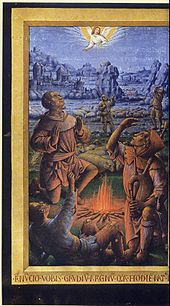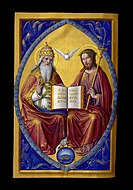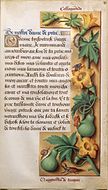
International Gothic is a period of Gothic art which began in Burgundy, France, and northern Italy in the late 14th and early 15th century. It then spread very widely across Western Europe, hence the name for the period, which was introduced by the French art historian Louis Courajod at the end of the 19th century.

Books of hours are Christian prayer books, which were used to pray the canonical hours. The use of a book of hours was especially popular in the Middle Ages, and as a result, they are the most common type of surviving medieval illuminated manuscript. Like every manuscript, each manuscript book of hours is unique in one way or another, but most contain a similar collection of texts, prayers and psalms, often with appropriate decorations, for Christian devotion. Illumination or decoration is minimal in many examples, often restricted to decorated capital letters at the start of psalms and other prayers, but books made for wealthy patrons may be extremely lavish, with full-page miniatures. These illustrations would combine picturesque scenes of country life with sacred images.

The Hours of Jeanne d'Evreux is an illuminated book of hours in the Gothic style. According to the usual account, it was created between 1324 and 1328 by Jean Pucelle for Jeanne d'Evreux, the third wife of Charles IV of France. It was sold in 1954 to the Metropolitan Museum of Art in New York where it is now part of the collection held at The Cloisters, and usually on display.

Barthélemy d'Eyck, van Eyck or d' Eyck, was an Early Netherlandish artist who worked in France and probably in Burgundy as a painter and manuscript illuminator. He was active between about 1440 to about 1469. Although no surviving works can be certainly documented as his, he was praised by contemporary authors as a leading artist of the day, and a number of important works are generally accepted as his. In particular, Barthélemy has been accepted by most experts as the artists formerly known as the Master of the Aix Annunciation for paintings, and the Master of René of Anjou for illuminated manuscripts. He is thought by many to be the Master of the Shadows responsible for parts of the calendar of the Très Riches Heures du Duc de Berry.
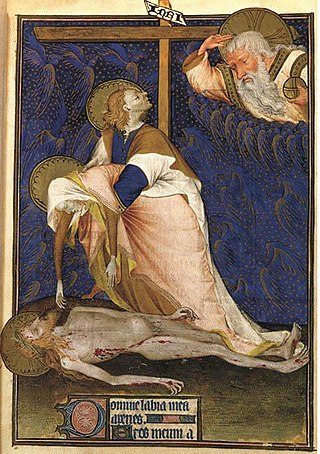
The Grandes Heures de Rohan is an illuminated manuscript book of hours, painted by the anonymous artist known as the Rohan Master, probably between 1418 and 1425, in the Gothic style. It contains the usual offices, prayers and litanies in Latin, along with supplemental texts, decorated with 11 full page, 54 half page, and 227 small miniatures, decorated with tempera paints and gold leaf. The book margins are decorated with Old Testament miniatures with captions in Old French, in the style of a Bible moralisée. The full page illuminations are renowned for the highly emotional and dramatic portrayal of the agonies of Christ and the grief of the Virgin. According to Millard Meiss, "The Rohan Master cared less about what people do than what they feel. Whereas his great predecessors excelled in the description of the novel aspects of the natural world, he explored the realm of human feeling." Meiss concludes that the Rohan Master was the "greatest expressionist in 15th century France." The manuscript is currently housed in the Bibliothèque Nationale, Paris, France.

The Turin–Milan Hours is a partially destroyed illuminated manuscript, which despite its name is not strictly a book of hours. It is of exceptional quality and importance, with a very complicated history both during and after its production. It contains several miniatures of about 1420 attributed to an artist known as "Hand G" who was probably either Jan van Eyck, his brother Hubert van Eyck, or an artist very closely associated with them. About a decade or so later Barthélemy d'Eyck may have worked on some miniatures. Of the several portions of the book, that kept in Turin was destroyed in a fire in 1904, though black-and-white photographs exist.

The Primer of Claude of France was the first book owned by the French princess Claude of France, eldest daughter of Louis XII of France and Anne of Brittany. Commissioned by Anne for Claude and produced in c. 1505, it is a rare surviving example of a manuscript designed for a medieval child.

The Black Hours, MS M.493 is an illuminated book of hours completed in Bruges between 1460 and 1475. It consists of 121 pages (leaves) with Latin text written in Gothic minuscule script. The words are arranged in rows of fourteen lines and follow the Roman version of the texts. The lettering is inscribed in silver and gold and placed within borders ornamented with flowers, foliage and grotesques, on pages dyed a deep blueish black; hence its designation as a Black books of hours. The book contains fourteen full-page miniatures and opens with the months of the liturgical calendar, followed by the Hours of the Virgin, and ends with the Office of the Dead.

Willem Vrelant was a Dutch book illuminator.

Jean Poyer, was a French miniature painter and manuscript illuminator of the late 15th century. As a multitalented artist - illuminator, painter, draftsman, and festival designer active from 1483 until his death - he was a painter of Renaissance France, working for the courts of three successive French kings: Louis XI, Charles VIII, and Louis XII.

The Petites Heures of Jean de France, Duc de Berry is an illuminated book of hours commissioned by John, Duke of Berry between 1375 and 1385–90. It is known for its ornate miniature leaves and border decorations.
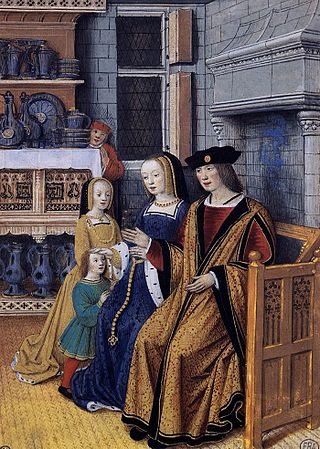
Jean Bourdichon was a French miniature painter and manuscript illuminator at the court of France between the end of the 15th century and the start of the 16th century, in the reigns of Louis XI of France, Charles VIII of France, Louis XII of France, and Francis I of France. He was probably born in Tours, and was a pupil of Jean Fouquet. He died in Tours.
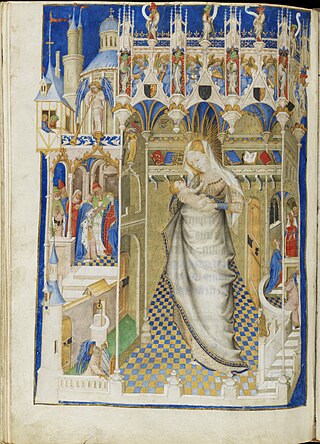
The Hours of Isabella Stuart, Duchess of Brittany is an illuminated Book of Hours produced at Angers either between 1417 and 1418 or before 1431, in the workshop of the Rohan Master, though there were contributions from other masters, including the Master of Giac and the Master of the Virgin.

The Hours of Margaret of Foix is an illuminated book of Hours, named after its patron, Margaret of Foix. It follows the Paris liturgy and was produced in France between 1471 and 1486. Many of the prayers included in this manuscript focus on childbirth, motherhood, and producing a male heir. The illuminations include scenes from the Passion of Christ and Christ's birth. It is now part of the Salting Collection in the Victoria and Albert Museum in London.

The Sforza Hours, is a richly illuminated book of hours initiated by Bona Sforza, widow of Galeazzo Sforza, Duke of Milan, around 1490, who commissioned the illuminator Giovanni Pietro Birago. The book remained in an unfinished state for 30 years until Margaret of Austria, Regent of the Netherlands, commissioned its completion in 1517–20 from the artist Gerard Horenbout. The book therefore contains decoration of the highest quality by two artists. It provides a unique example of an early sixteenth-century Northern Renaissance illuminator's response to Milanese art of the late Quattrocento. The history of the Sforza Hours also includes one of the earliest recorded examples of art theft.
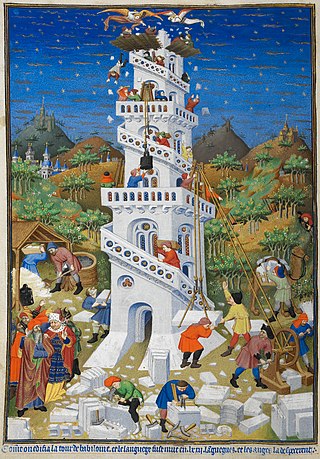
The Bedford Hours is a French late medieval book of hours. It dates to the early fifteenth century (c. 1410–30); some of its miniatures, including the portraits of the Duke and Duchess of Bedford, have been attributed to the Bedford Master and his workshop in Paris. The Duke and Duchess of Bedford gave the book to their nephew Henry VI in 1430. It is in the British Library, catalogued as Add MS 18850.

The Heures de Charles d'Angoulême is a book of hours commissioned in the late 15th century, probably around 1480, by Charles, Count of Angoulême, father of king Francis I of France. It is now in the Bibliothèque nationale de France in Paris, under the number Latin 1173.

The Hours of Louis XII was an illuminated manuscript book of hours produced by Jean Bourdichon for Louis XII of France. It was begun in 1498 or 1499, going by the king's age of 36 given below his portrait; he became king on 7 April 1498. The book reached England, where it was broken up around 1700. Now only parts of it survive – in total sixteen full-page miniature paintings, two sheets of text and fifty-one sheets of text bound in the wrong order as a thin volume.
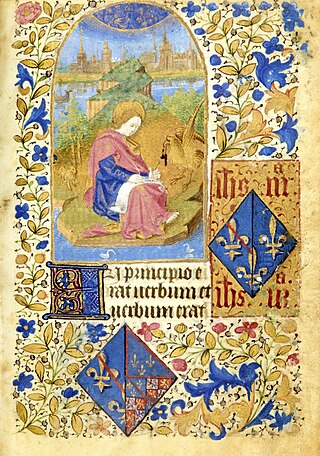
The book of hours of Joan of France is a 15th-century illuminated manuscript forming a book of hours, named after Joan of France, Duchess of Bourbon, who owned the book in the 15th century. After her death, it passed to Catherine of Armagnac, whose coat of arms was added to the book. After her death, the whereabouts of the book are unknown; it reappeared again in the late 19th century when it was bought by private collector Victor Martin Le Roy. It then passed to his son-in-law, art historian Jean-Joseph Marquet de Vasselot. It was again sold in 2011, and then bought by the Bibliothèque nationale de France, thanks to funding from private donors. It is classified as a national treasure of France. The rich decoration, including 28 full-page miniatures, was mostly made by the so-called Master of Jouvenel.

The Book of hours of Frederick of Aragon or simply the Hours of Frederick of Aragon is a luxury book of hours, a private devotional book, made for Frederick of Aragon between 1501 and 1502. Described as a "particularly accomplished work of art", it is the result of cooperation between three different artists, Ioan Todeschino, Jean Bourdichon, and the Master of Claude de France. The 62 full-page miniatures were made by Bourdichon, and have been described as some of his best work, while the border decorations were made by Todeschino and the Master of Claude de France. Following the death of Frederick, the book probably eventually ended up in Spain, and eventually entered the library of Joseph Bonaparte. It was eventually lost by him and finally bought by the predecessor of today's Bibliothèque nationale de France, the French national library, in 1828. It is kept in the library collections in Paris and has been exhibited to the public on several occasions.


